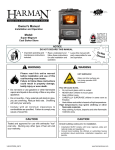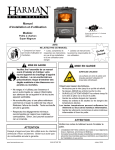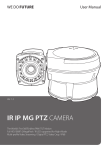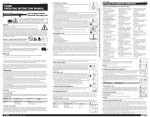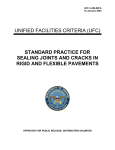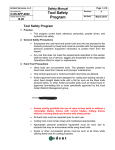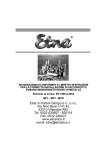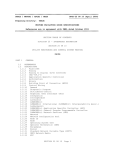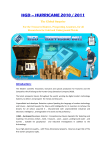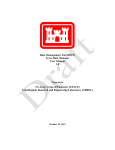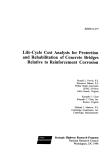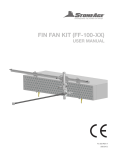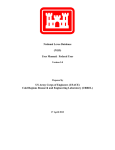Download Concrete Crack and Partial Depth Spall Repair Manual
Transcript
JP003P.qxd 4/21/04 11:30 AM Page 101 N CONC CA RI M EN AT I E PAV ON TE RE AM E Concrete Crack and Partial-Depth Spall Repair Manual T ASSOC I American Concrete Pavement Association JP003P.qxd 4/21/04 11:30 AM Page i Reprint from UNIFIED FACILITIES CRITERIA (UFC) Operation & Maintenance: CONCRETE CRACK AND PARTIAL-DEPTH SPALL REPAIR Edited and Annotated by the American Concrete Pavement Association U.S. ARMY CORPS OF ENGINEERS NAVAL FACILITIES ENGINEERING COMMAND AIR FORCE CIVIL ENGINEER SUPPORT AGENCY APPROVED FOR PUBLIC RELEASE: DISTRIBUTION UNLIMITED UFC 3-270-03 May 2004 Any copyrighted material included in this UFC is identified at its point of use. Use of the copyrighted material apart from this UFC must have the permission of the copyright holder. The format of this document does not conform to UFC 1-300-1. i JP003P.qxd 4/21/04 11:30 AM Page ii FOREWORD The Unified Facilities Criteria (UFC) system is prescribed by MILSTD 3007 and provides planning, design, construction, operations and maintenance criteria, and applies to all service commands having military construction responsibilities. UFC will be used for all service projects and work for other customers where appropriate. UFC are living documents and will be periodically reviewed, updated, and made available to users as part of the Services’ responsibility for providing technical criteria for military construction. Headquarters, United States Army Corps of Engineers (HQUSACE), Naval Facilities Engineering Command (NAVFAC), and Air Force Civil Engineer Support Agency (AFCESA) are responsible for administration of the UFC system.Technical content of UFC is the responsibility of the preparing tri-service committee. Recommended changes with supporting rationale should be sent to the respective service proponent office, as follows: • HQUSACE, ATTN: CECW-E, 441 G Street, NW, Washington, DC 20314-1000, or the Recommended Changes to Engineering Documents page on the TECHINFO site listed below. • HQUSACE, ATTN: CECW-E, 441 G Street, NW, Washington, DC 20314-1000, or the Recommended Changes to Engineering Documents page on the TECHINFO site listed below. • Commander, Atlantic Division, Naval Facilities Engineering Command, 1510 Gilbert Street (ATTN: NAVFAC Criteria Office), Norfolk, VA 23511-2699, or [email protected]. navy.mil, by commercial telephone (757) 322-4200, or DSN 262-4200, or by facsimile machine to (757) 322-4416. • Air Force Civil Engineer Support Agency, 139 Barnes Drive, Tyndall Air Force Base, FL 32403-5319, or larry.spangler@ tyndall.af.mil. UFC are effective upon issuance. UFC are distributed only in electronic media from the following sources: • USACE TECHINFO Internet site http://www.hnd.usace.army. mil/techinfo/index.htm. • NAVFAC Criteria Office Internet site http://criteria.navfac. navy.mil/criteria. • Construction Criteria Base (CCB) system maintained by the National Institute of Building Sciences on CD-ROM and at Internet site http://www.ccb.org/. Hard copies of UFC printed from electronic media should be checked against the current electronic version prior to use to ensure that they are current. FOREWORD BY ACPA This publication is annotated by the American Concrete Pavement Association. It is a reprint of a United Facilities Criteria document, UFC 3-270-04, and is an ACPA publication, JP002P. The ACPA wishes to thank the Tri-Services of the Department of Defense for allowing ACPA to annotate and reprint this document. ii JP003P.qxd 4/21/04 11:30 AM Page iii CONTENTS Chapter 1 – Introduction . . . . . . . . . . . . . . . . . . . . . . . . . . . . . . . . . 1 1.1. Preface . . . . . . . . . . . . . . . . . . . . . . . . . . . . . . . . . . . . . . . . 1 1.2. Safety Considerations . . . . . . . . . . . . . . . . . . . . . . . . . . . . . 1 1.3. References . . . . . . . . . . . . . . . . . . . . . . . . . . . . . . . . . . . . . 1 Table 1.1. American Society for Testing and Materials (ASTM). . . . . . . . . . . . . . . . . . . . . . . . . . . . 3 Table 1.2. American Concrete Institute (ACI). . . . . . . . . . . . . . . 5 Table 1.3. American Concrete Pavement Association (ACPA) . . . . . . . . . . . . . . . . . . . . . . . . . . 5 Chapter 2 – Purpose of Crack and Partial-Depth Spall Repair . . . 7 2.1. Description . . . . . . . . . . . . . . . . . . . . . . . . . . . . . . . . . . . . . 7 2.2. Objective . . . . . . . . . . . . . . . . . . . . . . . . . . . . . . . . . . . . . . . 7 2.3. Airfield Inspections . . . . . . . . . . . . . . . . . . . . . . . . . . . . . . . 7 2.4. Cracks . . . . . . . . . . . . . . . . . . . . . . . . . . . . . . . . . . . . . . . . . 8 2.5. Spalls . . . . . . . . . . . . . . . . . . . . . . . . . . . . . . . . . . . . . . . . . 8 2.6. Moderate-Severity Spalling . . . . . . . . . . . . . . . . . . . . . . . . . 9 Chapter 3 – Crack Sealing and Repair . . . . . . . . . . . . . . . . . . . . . 11 3.1. Description. . . . . . . . . . . . . . . . . . . . . . . . . . . . . . . . . . . . . 11 3.2. Test Section . . . . . . . . . . . . . . . . . . . . . . . . . . . . . . . . . . . . 11 3.3. Sealant Selection . . . . . . . . . . . . . . . . . . . . . . . . . . . . . . . 11 3.4. Shape Factor and Recess . . . . . . . . . . . . . . . . . . . . . . . . 12 3.5. Sandblasting . . . . . . . . . . . . . . . . . . . . . . . . . . . . . . . . . . . 12 3.6. Removing Loose Material . . . . . . . . . . . . . . . . . . . . . . . . . 12 3.7. Vacuuming. . . . . . . . . . . . . . . . . . . . . . . . . . . . . . . . . . . . . 12 3.8. Cleanliness . . . . . . . . . . . . . . . . . . . . . . . . . . . . . . . . . . . . 12 3.9. Backer Rod . . . . . . . . . . . . . . . . . . . . . . . . . . . . . . . . . . . . 13 3.10. Foreign Object Damage . . . . . . . . . . . . . . . . . . . . . . . . . 13 Chapter 4 – Backer and Sealant Materials. . . . . . . . . . . . . . . . . . 15 4.1. Description . . . . . . . . . . . . . . . . . . . . . . . . . . . . . . . . . . . . 15 4.2. Separating Materials . . . . . . . . . . . . . . . . . . . . . . . . . . . . . 16 4.3. Fuel and Blast Resistance . . . . . . . . . . . . . . . . . . . . . . . . 16 4.4. Navy Regulations . . . . . . . . . . . . . . . . . . . . . . . . . . . . . . . 16 4.5. U.S. Army and Air Force Regulations . . . . . . . . . . . . . . . . 16 Chapter 5 – Shape Factors. . . . . . . . . . . . . . . . . . . . . . . . . . . . . . 17 5.1. Description . . . . . . . . . . . . . . . . . . . . . . . . . . . . . . . . . . . . 17 5.2. Silicone Sealants. . . . . . . . . . . . . . . . . . . . . . . . . . . . . . . . 17 Chapter 6 – Crack Repair Equipment. . . . . . . . . . . . . . . . . . . . . . 21 6.1. Description . . . . . . . . . . . . . . . . . . . . . . . . . . . . . . . . . . . . 21 6.2. Random Crack Saw . . . . . . . . . . . . . . . . . . . . . . . . . . . . . 21 6.3. Vertical Spindle Router . . . . . . . . . . . . . . . . . . . . . . . . . . . 22 iii JP003P.qxd 4/21/04 11:30 AM Page iv 6.4. Sandblasting Equipment . . . . . . . . . . . . . . . . . . . . . . . . . . 22 6.5. Waterblasting Equipment . . . . . . . . . . . . . . . . . . . . . . . . . 23 6.6. Hot-Air Lance . . . . . . . . . . . . . . . . . . . . . . . . . . . . . . . . . . 24 6.7. Power Broom . . . . . . . . . . . . . . . . . . . . . . . . . . . . . . . . . . 24 6.8. Compressed Air Equipment . . . . . . . . . . . . . . . . . . . . . . . 24 6.9. Backer Rod Installation Equipment. . . . . . . . . . . . . . . . . . 24 6.10. Hot-Applied Sealant Equipment . . . . . . . . . . . . . . . . . . . 25 6.11. Cold-Applied Sealant Equipment . . . . . . . . . . . . . . . . . . 25 Chapter 7 – Crack Preparation . . . . . . . . . . . . . . . . . . . . . . . . . . . 27 7.1. Description . . . . . . . . . . . . . . . . . . . . . . . . . . . . . . . . . . . . 27 7.2. Cleaning . . . . . . . . . . . . . . . . . . . . . . . . . . . . . . . . . . . . . . 28 Chapter 8 – Crack Sealing Procedures . . . . . . . . . . . . . . . . . . . . 29 8.1. Description . . . . . . . . . . . . . . . . . . . . . . . . . . . . . . . . . . . . 29 8.2. Preparation . . . . . . . . . . . . . . . . . . . . . . . . . . . . . . . . . . . . 29 Chapter 9 – Partial-Depth Spall Repair . . . . . . . . . . . . . . . . . . . . 31 9.1. Description . . . . . . . . . . . . . . . . . . . . . . . . . . . . . . . . . . . . 31 9.2. Test Area . . . . . . . . . . . . . . . . . . . . . . . . . . . . . . . . . . . . . . 34 9.3. Selecting Repair Materials and Procedure . . . . . . . . . . . . 34 9.4. Removing Old Sealant . . . . . . . . . . . . . . . . . . . . . . . . . . . 34 9.5. Boundaries . . . . . . . . . . . . . . . . . . . . . . . . . . . . . . . . . . . . 35 9.6. Concrete Removal . . . . . . . . . . . . . . . . . . . . . . . . . . . . . . 35 9.7. Concrete Soundness. . . . . . . . . . . . . . . . . . . . . . . . . . . . . 35 9.8. Cleaning . . . . . . . . . . . . . . . . . . . . . . . . . . . . . . . . . . . . . . 35 9.9. Sweeping . . . . . . . . . . . . . . . . . . . . . . . . . . . . . . . . . . . . . 35 9.10. Joint Re-former . . . . . . . . . . . . . . . . . . . . . . . . . . . . . . . . 36 9.11. Bonding Agent . . . . . . . . . . . . . . . . . . . . . . . . . . . . . . . . . 36 9.12. Sawing . . . . . . . . . . . . . . . . . . . . . . . . . . . . . . . . . . . . . . 36 9.13. Cleanup . . . . . . . . . . . . . . . . . . . . . . . . . . . . . . . . . . . . . . 36 Chapter 10 – Spall Repair Materials. . . . . . . . . . . . . . . . . . . . . . . 37 10.1. Specifications . . . . . . . . . . . . . . . . . . . . . . . . . . . . . . . . . 37 10.2. Alternative Repair Materials . . . . . . . . . . . . . . . . . . . . . . 37 Chapter 11 – Spall Repair Equipment . . . . . . . . . . . . . . . . . . . . . 39 11.1. Description. . . . . . . . . . . . . . . . . . . . . . . . . . . . . . . . . . . . 39 11.2. Concrete Saw . . . . . . . . . . . . . . . . . . . . . . . . . . . . . . . . . 39 11.3. Jackhammers . . . . . . . . . . . . . . . . . . . . . . . . . . . . . . . . . 39 11.4. Mixers . . . . . . . . . . . . . . . . . . . . . . . . . . . . . . . . . . . . . . . 39 11.5. Hand Tools. . . . . . . . . . . . . . . . . . . . . . . . . . . . . . . . . . . . 39 Chapter 12 – Spall Repair Preparation. . . . . . . . . . . . . . . . . . . . . 41 12.1. Description . . . . . . . . . . . . . . . . . . . . . . . . . . . . . . . . . . . 41 12.2. Boundaries . . . . . . . . . . . . . . . . . . . . . . . . . . . . . . . . . . . 41 12.3. Soundness . . . . . . . . . . . . . . . . . . . . . . . . . . . . . . . . . . . 42 iv JP003P.qxd 4/21/04 11:30 AM Page v Chapter 13 – Spall Repair Procedures. . . . . . . . . . . . . . . . . . . . . 43 13.1. Description . . . . . . . . . . . . . . . . . . . . . . . . . . . . . . . . . . . 43 13.2. Joint Re-former . . . . . . . . . . . . . . . . . . . . . . . . . . . . . . . . 43 13.3. Bonding Agents . . . . . . . . . . . . . . . . . . . . . . . . . . . . . . . . 44 13.4. Mixing and Placing . . . . . . . . . . . . . . . . . . . . . . . . . . . . . 44 13.5. Consolidation . . . . . . . . . . . . . . . . . . . . . . . . . . . . . . . . . 44 13.6. Curing . . . . . . . . . . . . . . . . . . . . . . . . . . . . . . . . . . . . . . . 46 13.7. Resealing . . . . . . . . . . . . . . . . . . . . . . . . . . . . . . . . . . . . 46 13.8. Placing Sealant . . . . . . . . . . . . . . . . . . . . . . . . . . . . . . . . 47 13.9. Cleanup . . . . . . . . . . . . . . . . . . . . . . . . . . . . . . . . . . . . . . 47 Chapter 14 – Common Problems & Solutions . . . . . . . . . . . . . . . 49 14.1. Joint/Crack Sealing & Resealing. . . . . . . . . . . . . . . . . . . 49 14.2. Partial-Depth Spall Repair. . . . . . . . . . . . . . . . . . . . . . . . 51 v JP003P.qxd vi 4/21/04 11:30 AM Page vi JP003P.qxd 4/21/04 11:30 AM Page 1 Chapter 1 – Introduction CHAPTER 1 INTRODUCTION 1.1. Preface – This handbook describes methods and procedures for the repair of cracks and spalls in concrete pavements as well as the selection of materials and equipment. This handbook is intended for use as a field handbook for airfield concrete pavement repair for all U.S. Navy, Army, and Air Force facilities; however, the techniques for repair can be used for other concrete pavements as well. References are provided for additional information on pavement repair practices not addressed in this manual. Tables 1.1, 1.2, and 1.3 list applicable American Society of Testing and Materials (ASTM) specifications, American Concrete Institute (ACI) publications, and American Concrete Pavement Association (ACPA) publications. 1.2. Safety Considerations – It is the responsibility of supervisory personnel to ensure worker safety by informing the workers of any potential hazardous practices. Follow the applicable Occupational Safety and Health Administration (OSHA) guidelines at all times for hazardous practices such as sandblasting joints and cracks, airblasting for cleaning cracks, and working with chemicals. Workers are required to be informed of all hazardous materials and practices that may involve exposure to toxic materials in the workplace. Material Safety Data Sheets must be available to all workers at the work site. 1.3. References 1.3.1. Department of the Navy, Naval Facilities Engineering Command. (1994). “Concrete Pavement Repair Manual,” MIL-HDBK-1102/7.2, Norfolk, Virginia. 1.3.2. Headquarters, Departments of the Army and Air Force. (1989). “Procedures for U.S. Army and U.S. Air Force Airfield Pavement Condition Surveys,” TM 5-8266/AFM 93-5, Washington, DC. 1.3.3. Unified Facilities Guide Specification. (Sept. 1999). “Resealing of Joints in Rigid Pavement,” UFGS02982N. 1.3.4. Air Force Civil Engineer Support Agency. (1996). “Silicone Joint Sealants for Pavements,” Engineering Technical Letter ETL 96-4, Tyndall Air Force Base, Florida. 1 JP003P.qxd 4/21/04 11:30 AM Page 2 1.3.5. Unified Facilities Guide Specification. (1997). “Field Molded Sealants for Sealing Joints in Rigid Pavements,” UFGS-02760A. 1.3.6. Headquarters, Departments of the Army and Air Force. (1989). “Repair of Rigid Pavements Using EpoxyResin Grouts, Mortars, and Concrete,” TM 5-822-9/AFM 88-6, Chapter 10, Washington, DC. 1.3.7. Evans, L. D., and Romine, A. R. (1993). “Materials and Procedures for the Rapid Repair of Joint Seals in Concrete Pavements,” SHRP-H-349, Strategic Highway Research Program, Transportation Research Board, Washington, DC. 1.3.8. Unified Facilities Criteria. (2003). “O&M: Concrete Repair,” UFC 3-270-04, ACPA JP002P. 1.3.9. Unified Facilities Guide Specification. (Sept. 1999). “Patching of Rigid Pavement Partial Depth,” UFGS-02983N. 1.3.10. Unified Facilities Guide Specification. (Aug. 1997). “Patching of Rigid Pavements,” UFGS-02980A. 1.3.11. Evans, L. D. et al. (1993). “Materials and Procedures for Rapid Repair of Partial-Depth Spalls in Concrete Pavements,” SHRP-H-349, Strategic Highway Research Program, Transportation Research Board, Washington, DC. 1.3.12. American Association of State Highway and Transportation Officials (AASHTO). (1991). “Burlap Cloth Made From Jute or Kenaf,” AASHTO M 182, Washington, DC. 1.3.13. U.S. Army Corps of Engineers Waterways Experiment Station. (1990). “Specification for MembraneForming Compounds for Curing Concrete,” CRD-C 30090, Handbook for Concrete and Cement, Vicksburg, MS. 2 JP003P.qxd 4/21/04 11:30 AM Page 3 Chapter 1 – Introduction Table 1.1. American Society for Testing and Materials (ASTM) Specifications for Sealants, Joint Fillers, Patching Materials, etc. Joint and Crack Repair ASTM C 603 (1997) ASTM C 639 (2001) ASTM C 661 (1998) ASTM C 679 (1997) ASTM C 719 (1998) ASTM C 792 (1998) ASTM C 793 (2002) ASTM D 412 (1998) ASTM D 1751 (1999) ASTM D 1752 (1996) ASTM D 2628 (1998) ASTM D 2835 (1998) ASTM D 3406 (2000) ASTM D 3569 (2000) ASTM D 5893 (1996) ASTM D 6690 (2001) Extrusion Rate and Application Life of Elastomeric Sealants Rheological (Flow) Properties of Elastomeric Sealants Indentation Hardness of ElastomericType Sealants by Means of a Durometer Tack-Free Time of Elastomeric Sealants Adhesion and Cohesion of Elastomeric Joint Sealants under Cyclic Movement Effects of Heat Aging on Weight Loss, Cracking, and Chalking of Elastomeric Joint Sealants Effects of Accelerated Weathering on Elastomeric Joint Sealants Vulcanized Rubber and Thermoplastic Rubbers and Thermoplastic Elastomers – Tension Preformed Expansion Joint Filler for Concrete Paving and Structural Construction (Nonextruding and Resilient Bituminous Types) Preformed Sponge Rubber and Cork Expansion Joint Fillers for Concrete Paving and Structural Construction Preformed Polychloroprene Elastomeric Joint Seals for Concrete Pavements Lubricant for Installation of Preformed Compression Seals on Concrete Pavements Joint Sealant, Hot-Applied, ElastomericType, for Portland Cement Concrete Pavements Joint Sealant, Hot-Applied, Elastomeric, Jet-Fuel-Resistant-Type for Portland Cement Concrete Pavements Cold-Applied, Single Component Chemically Curing Silicone Joint Sealant for Portland Cement Concrete Pavements Joint and Crack Sealants, Hot-Applied, for Concrete and Asphalt Pavements 3 JP003P.qxd 4/21/04 11:30 AM Page 4 Table 1.1. American Society for Testing and Materials (ASTM) Specifications for Sealants, Joint Fillers, Patching Materials, etc., Continued Spall Repair ASTM C 31 (2000) ASTM C 33 (2002) ASTM C 39 (2001) ASTM C 94 (2000) ASTM C 131 (2001) ASTM C 136 (2001) ASTM C 143 (2000) ASTM C 150 (2002) ASTM C 171 (1997) ASTM C 173 (2001) ASTM C 231 (1997) ASTM C 260 (2001) ASTM C 309 (1998) ASTM C 494 (1999) ASTM C 881 (2002) 4 Making and Curing Concrete Test Specimens in the Field Concrete Aggregates Compressive Strength of Cylindrical Concrete Specimens Ready-Mixed Concrete Resistance to Degradation of Small-Size Coarse Aggregate by Abrasion and Impact in the Los Angeles Machine Sieve Analysis of Fine and Coarse Aggregates Slump of Hydraulic Cement Concrete Portland Cement Sheet Materials for Curing Concrete Air Content of Freshly Mixed Concrete by the Volumetric Method Air Content of Freshly Mixed Concrete by the Pressure Method Air-Entraining Admixtures for Concrete Liquid Membrane-Forming Compounds for Curing Concrete Chemical Admixtures for Concrete Epoxy-Resin-Base Bonding Systems for Concrete JP003P.qxd 4/21/04 11:30 AM Page 5 Chapter 1 – Introduction Table 1.2. American Concrete Institute (ACI) Publications That Detail Good Practices for Concrete Repair Work ACI 305R-99 ACI 306R-88 ACI 308-01 ACI 548.1R-97 Hot-Weather Concreting Cold-Weather Concreting Guide to Curing Concrete Guide for the Use of Polymers in Concrete Table 1.3. American Concrete Pavement Association (ACPA) Publications Pertaining to Joint, Crack, and Spall Repair That Detail Good Practices for Concrete Repair Work ACPA TB012P ACPA SR903P ACPA TB003P ACPA TB020P ACPA TB002P Joint and Crack Sealing and Repair for Concrete Pavements Stitching Concrete Pavement Cracks and Joints Guidelines for Partial-Depth Spall Repair Concrete Pavement Restoration Guide: Procedures for Preserving Concrete Pavements Guidelines for Full-Depth Repair Table 1.4. Federal Specifications for Sealants SS-S-200E SS-S-1614A Sealants, Joint, Two-Component, Jet-BlastResistant, Cold-Applied, for Portland Cement Concrete Pavement Sealants, Joint, Jet-Fuel Resistant, HotApplied, for Portland Cement Concrete Pavements 5 JP003P.qxd 6 4/21/04 11:30 AM Page 6 JP003P.qxd 4/21/04 11:30 AM Page 7 Chapter 2 – Purpose of Crack and Partial-Depth Spall Repair CHAPTER 2 PURPOSE OF CRACK SEALING AND PARTIAL-DEPTH SPALL REPAIR 2.1. Description – The primary purpose of sealing joints and cracks, and repairing spalls in portland cement concrete pavements on airfields is to reduce the costs associated with foreign object damage (FOD) and to prolong the service life of the pavement, reducing the lifecycle costs for the pavement structure. A considerable investment has been made in the construction of a concrete surface and the vehicles that use these surfaces; therefore, costs decrease dramatically for every additional year of pavement use that does not cause vehicle damage or require repeated patching or full slab replacement. Routine periodic inspections and rapid repair of pavement problems are essential for reducing life-cycle costs (References 1.3.1 and 1.3.2). A properly constructed and maintained concrete pavement can last for many years. 2.2. Objective – The objective of joint/crack sealing and spall repair is to reduce FOD and to minimize moisture or incompressible material (rocks, sand, other pieces of concrete, etc.) entering into the crack or joint. Unsealed joints and cracks will allow moisture to penetrate under the slab causing an increase in the moisture content in the base and/or subbase. As thermal cycling occurs and the joint or crack expands and contracts, incompressible material such as rocks, chunks of concrete, sand, or ice in the crack may cause stress to build in the slab. Such stress can result in more spalling or cracking and further damage to the slab, thereby increasing the potential for FOD. 2.3. Airfield Inspections – For airfields, conduct inspections of the pavement surfaces receiving traffic at least monthly to locate spalls or cracks that may cause FOD. Otherwise, conduct routine field evaluations at least biannually, once during the summer and once during the winter. Seasonal checks allow for evaluation of the material during the two extremes of ambient conditions. Locate and inspect all cracks and spalls. If concrete has begun to break away from the crack or spalled area, repair the damaged area. 7 JP003P.qxd 4/21/04 11:30 AM Page 8 2.4. Cracks – Cracks less than 3/16 in. (5 mm) wide and without any surface spalling do not require repair or sealing. Seal all cracks between 3/16 in. (5 mm) and 2 in. (50 mm) wide. Cracks larger than 2 in. (50 mm) require full-depth patching. Use of a backer rod is recommended for all crack sealing, unless irregular crack dimensions preclude its use. If spalling is present adjacent to a crack (of any width), repair the damaged area by treating the crack the same as a joint. The sealed crack protects the repaired area from damage that might result from movement of the slab along the crack faces. 2.5. Spalls – Spalling is generally caused by incompressible materials in the joints and cracks that prevent the necessary movement of the slab due to thermal fluctuations, thereby causing breaks in the concrete adjacent to the joint or crack (Figure 2.1). Minor spalls may also be caused by snowplows, overworking of the plastic concrete, or popouts. To repair a spalled area, remove incompressible materials from the joint or crack, patch the spalled area, and replace the sealant. Additional repairs of previous spall repairs due to failure of the material or poor repair practices are also common. If the spall depth is greater than 1/3 the slab depth, full-depth patching is needed. Full-depth patching will not be covered in this manual but is addressed in Reference 1.3.8 or ACPA TB002P. Cracking of slabs can be due to load-related failure or environmental stress on the slab. Figure 2.1. Incompressibles causing spalling in joint or crack. 8 JP003P.qxd 4/21/04 11:30 AM Page 9 Chapter 2 – Purpose of Crack and Partial-Depth Spall Repair 2.6. Moderate to Severe Spalling – An example of moderate to severe spalling is shown in Figure 2.2. Spalls are present along the face of the joint. Missing chunks of concrete are visible with the potential for more pieces to become dislodged and cause FOD. Repair all spalled areas that have loose concrete to reduce FOD potential. Figure 2.2. Moderate to severe spalling along a joint. 9 JP003P.qxd 10 4/21/04 11:30 AM Page 10 JP003P.qxd 4/21/04 11:30 AM Page 11 Chapter 3 – Crack Sealing and Repair CHAPTER 3 CRACK SEALING & REPAIR ACPA NOTE: ACPA does not recommend the use of crack routers due to the chipping and micro-cracking damage this equipment causes to the concrete. ACPA recommends small diameter crack-tracing saw blades to prepare a sealant reservoir. ACPA recommends that water be used only to flush the joint of sawing slurry. Waterblasting is not recommended after the joints are sandblasted. ACPA cautions personnel on use of hot-air lances to dry seal reservoirs. Over-heating can damage the concrete. 3.1. Description – The recommended method for preparing cracks with no raveling along the edges is to saw the crack with a small-diameter blade or rout it to the proper depth and width for the particular sealant and backer rod. Sandblast each face of the sawcut or routed crack. The crack faces are then cleaned with highpressure water and/or air and the area swept with a vacuum-broom to prevent the material from re-entering the sawed crack. Waterblasting is typically only needed immediately after using a wet saw, whereas sandblasting is used after a dry saw. Small sections of repair are made at a time to prevent the sawed crack faces from being exposed to the elements for more than 24 hours. If the cracks are wet, they may be dried with a hot-air lance or high-pressure air compressor equipped with an operating water and oil separator before placing the sealant and backer rod. Use a sealant conforming to the applicable ASTM specifications and approved for use at a particular facility by the engineer. The sealant is placed in the crack from the bottom up and in one smooth run from the beginning to the end of the crack. Fill the crack to a depth of 1/8 to 1/4 in. (3 to 6 mm) below the surface of the pavement for conventional sealant (Reference 1.3.3) and 1/4 to 3/8 in. (6 to 9 mm) for silicone sealant (Reference 1.3.4). 3.2. Test Section – Construct a test section of approximately 200 linear feet (61 m) of sealed cracks to be approved by the contracting officer before beginning the full crack sealing project. Use the same procedures and materials in the test section that will be used in the full 11 JP003P.qxd 4/21/04 11:30 AM Page 12 project. Ensure that crack sawing or routing does not cause spalling. Clean the crack faces before placement of any sealant. For two-component sealants, verify the correct mixing ratio to within a specified tolerance according to the manufacturer’s specifications for that particular sealant. If using hot-applied sealants, use calibrated thermometers to verify correct application temperatures. Ensure that all equipment is in good working condition and operating properly. Additional details on joint and crack repair are given in References 1.3.5 through 1.3.8 and in Table 1.3. 3.3. Sealant Selection – Select the proper sealant material for the area being repaired (Chapter 4, “Backer and Sealant Materials”); however, ensure that the selected sealant conforms to appropriate specifications and is authorized by the engineer before use. Normally, it should match adjacent sealants. However, do not use neoprene compression seals for cracks. Time the repair such that prepared cracks are not exposed for more than 24 hours before sealing. If the cracks get wet or are cleaned with high-pressure waterblasting, continue the sealing operation only when the cracks are completely dry. The cracks may be dried with a heat lance, as long as proper precautions are followed to prevent heat damage to the concrete. 3.4. Shape Factor and Recess – Saw or rout (Figures 6.1 and 6.2) the crack to the proper width and depth to reach the desired shape factor and recess (Chapter 5, “Shape Factors”) recommended by the manufacturer of the sealant to be used. For silicone sealants, use of a backer rod in lieu of separating tape is recommended (Chapter 4, “Backer and Sealant Materials”). Small cracks may be sawed by hand. 3.5. Sandblasting – Clean the crack faces by light sandblasting using the multiple pass technique (Figures 6.3 and 7.3). While standing to one side of the crack, pass the wand along the crack face at an angle to allow a strong blast on one crack face; then step to the other side of the crack and reverse direction. Direct the nozzle to the location where the sealant will bond to the concrete, and not above or below this region. 3.6. Removing Loose Material – Blow debris out of the crack using compressed air; then clean the crack with high-pressure water (not recommended by ACPA) (Figure 12 JP003P.qxd 4/21/04 11:30 AM Page 13 Chapter 3 – Crack Sealing and Repair 6.4). Ensure that there is no loose material in the bottom of the crack. 3.7. Vacuuming – Clean the area around the crack with a vacuum sweeper to prevent debris from re-entering the crack before sealing (Figure 6.5). Compressed air may be required to re-clean crack if a power broom is used. 3.8. Cleanliness – Remember that the cleanliness of both crack faces is extremely important! Dirty crack faces are a major cause of loss of adhesion of the sealant and subsequent failure of the crack repair. Place the sealant within 24 hours after cleaning. If sealant is not placed within 24 hours, clean the crack again before sealing. If a finger wiped along the crack face picks up dirt or dust, the crack face is dirty and must be cleaned (Figure 7.3). Wait until the pavement is completely dry before sealing. 3.9. Backer Rod – Place the backer rod immediately prior to sealing the crack (Figure 6.6). Ensure that the backer rod is at least 25 percent larger in diameter than the width of the crack and is placed at the proper depth for the shape factor of the sealant being used (Figure 5.1). Seal the crack from the bottom up and from beginning to end in one stroke without interruption, when practical (Figures 8.1 and 13.5). 3.10. Foreign Object Damage – After the crack repair operation is complete, clean the surrounding pavement and sweep away all potential materials that may cause foreign object damage (FOD). Clean, lubricate, and properly store all equipment until the next repair operation. 13 JP003P.qxd 14 4/21/04 11:30 AM Page 14 JP003P.qxd 4/21/04 11:30 AM Page 15 Chapter 4 – Backer and Sealant Materials CHAPTER 4 BACKER AND SEALANT MATERIALS 4.1. Description – Concrete crack repair sealants are essentially the same as joint sealants and are designed to mitigate two problem areas, moisture intrusion into the pavement base and debris retention in the crack opening. The influx of moisture through a crack into the pavement base layer can seriously reduce the strength of the base and the ability to sustain a load. It can also erode underlying material and cause pumping. Debris retention is a particular problem due to thermal movement of the slab at the crack. If incompressible material is present in the crack and the slab expands due to thermal changes, spalling may result due to the inability of the stress to be relieved through movement of the slab at the crack. Backer material is placed in the sawed crack to minimize excess stress on the sealant material from improper shape factors and to prevent three-sided adhesion which inhibits the ability of the sealant to expand and compress under thermal stress. Typically, backer materials are rope-shaped and are often referred to as “backer rod” (Figure 4.1). Ensure that the backer material is compatible with the sealant, flexible to conform to the shape of the crack path, non-absorptive to prevent water retention, non-shrinkable, and compressible to allow for easy installation. Follow the sealant manufacturer’s recommendations on the type of backer rod needed for a particular sealant. Figure 4.1. Installation of backer rod into joint. 15 JP003P.qxd 4/21/04 11:30 AM Page 16 Typical backer materials are polychloroprene, polystyrene, polyurethane, and polyethylene closed-cell foams. Do not use paper, rope, or cord. Ensure that the melting temperature of the backer material is at least 25°F (14°C) higher than the sealant application temperature to prevent damage during sealant placement. Ensure that the uncompressed backer rod has a diameter at least 25% larger than the sealant reservoir so that it remains in position during the sealing operation. The use of backer rod is recommended prior to sealant placement in repairing cracks. 4.2. Separating Materials – Separating tape may be employed when the sealant reservoir dimensions correspond to the proper shape factor and the use of backer material would lead to an incorrect shape factor for that sealant material. Separating materials are usually a thin adhesive tape or a flexible plastic strip employed to prevent three-sided adhesion of the sealant. These materials must be flexible enough to deform with the sealant as the concrete expands and contracts. However, only use separating materials when the crack has been sawed to provide a reservoir of the proper depth. 4.3. Fuel and Blast Resistance – Additional considerations for the crack repair material are jet fuel and jet blast resistance. The crack to be repaired may be located in an area in which fuel or lubricating or hydraulic fluid spillage may occur or in an area subjected to high temperature from jet blast or exhaust from auxiliary power units. Use a repair material that conforms to ASTM and/or federal specifications designated for joint and crack sealants for use in these areas, as listed in Table 1.1 under “Joint and Crack Repair” and Table 1.4. 4.4. Navy Regulations – Naval regulations require that all materials used on U.S. Navy facilities conform to UFGS02982N (Reference 1.3.3). The Navy recommends use of silicone sealants on all Naval facilities and as an alternative to materials meeting ASTM D 5893, if approved by the engineer. Silicone sealants may be used in place of preformed neoprene sealants for new joints if cost is a major factor (References 1.3.3 and 1.3.4). 4.5. U.S. Army and Air Force Regulations – Sealants used on U.S. Army and Air Force pavements must conform to the ASTM specifications listed in Table 1.1 under “Joint and Crack Repair.” Preformed neoprene compression seals are common on Air Force pavements. 16 JP003P.qxd 4/21/04 11:30 AM Page 17 Chapter 5 – Shape Factors CHAPTER 5 SHAPE FACTORS ACPA NOTE: ACPA does not recommend the use of crack routers due to the chipping and micro-cracking damage this equipment causes to the concrete. ACPA recommends small diameter crack-tracing saw blades to prepare a sealant reservoir. 5.1. Description – For proper crack sealing, route or saw the crack to a designated width and depth for the particular type of sealant employed in the crack repair. The dimensions of a typical crack reservoir (Figure 5.1) are defined by a shape factor (S = D/W) that is the ratio of the depth of the sealant (D) to its width (W). Shape factors generally range from 0.5 to 2.0; however, these dimensions may be particular for the type of sealant employed in the repair operation and a recommended value will be supplied by the sealant manufacturer. 5.2. Silicone Sealants – Silicone sealants require a shape of approximately 0.5 (Reference 1.3.3). For example, if the width (W) of the sawed crack is 1/2 in. (13 mm), the depth of the sawed crack (T) must be 1.25 in. (30 mm) to accommodate a backer rod of 5/8 in. (16 mm). The top of the backer rod will be 1/2 in. (13 mm) below the pavement surface. This allows for a depth (D) of 1/4 to 3/8 in. (6 to 9 mm) of silicone sealant on top of the crown of the backer rod to keep the sealant at 1/8 to 1/4 in. (3 to 6 mm) below the pavement surface. 17 JP003P.qxd 4/21/04 Sealant Material 11:30 AM Page 18 1/4" (6 mm) recess typ. W 1" (32 mm) minimum Backer Rod Joint or Crack Field Poured Sealant Hot-Poured Sealant – D/W = 1 (typical) Silicone Sealant – D/W = 0.5 (typical) Two-Component Material Cold Poured – D/W = 0.5 (typical) 1/4" (6 mm) Chamfer or Radius* 1/4" (6 mm) Recess Typ. Sealant Material 1" (25 mm) max. Bond Breaker Non-Extruding Pre-Molded Compressible Material 1" (25 mm) max. Isolation Joint *Chamfer for airfield pavement subjected to heavy-load aircraft 18 JP003P.qxd 4/21/04 11:30 AM Page 19 Chapter 4 – Backer and Sealant Materials W Preformed Neoprene Compression Seal 1/4" (6 mm) Recess Typ. D As Required by Manufacturer Joint Preformed Seal Preformed Compression Seal – W Sized for Slab and Climate Only for New Pavement Joints Figure 5.1. (3) Typical sealant reservoir details and shape factors for joints or cracks. 19 JP003P.qxd 20 4/21/04 11:30 AM Page 20 JP003P.qxd 4/21/04 11:30 AM Page 21 Chapter 6 – Crack Repair Equipment CHAPTER 6 CRACK REPAIR EQUIPMENT 6.1. Description – Inspect all equipment employed in the crack repair operation before, during, and after the repair project to ensure proper operation of the equipment, safety of the personnel involved in the project, and potential damage to the pavement due to equipment problems. Follow proper safety procedures in accordance with OSHA guidelines and common sense practices for the protection of all project personnel. Use hand tools for working in areas where machinery is not practical or allowed. All sealant equipment must be equipped with nozzles designed to fill the cracks from the bottom up. Inspect the equipment daily, prior to application of the sealant, and during the operation to ensure safe operation and that the sealant is being applied properly. If a two-component sealant is used, the metering ratio must be checked daily. Refer to sealant manufacturer’s recommendations for proper equipment to be used. 6.2. Random Crack Saw – Sawing is the preferred method for preparing cracks for sealing. This device is essentially a concrete saw but has a smaller rear-mounted blade approximately 7 in. (175 mm) in diameter (Figure 6.1). These saws are generally self-propelled machines with caster wheels that allow more freedom of movement than an ordinary concrete saw for following the path of cracks. Use diamond blades manufactured for tracing cracks, which are wide enough to cut each edge of the crack and will not warp during operation. Figure 6.1. Random crack saw. 21 JP003P.qxd 4/21/04 11:30 AM Page 22 6.3. Vertical Spindle Router – Cracks may be routed out if a saw is not available. The vertical spindle router has a vertically mounted router bit and is constructed such that the device can caster and easily follow the contours of a crack (Figure 6.2). The bit must be the proper size for the sealant reservoir and be belt-driven for safety considerations arising from jamming of the bit if the router is forced along the crack. Use proper size bits that yield the proper shape for the sealant reservoir and do not cause spalling or raveling along the crack path. (This type of equipment is not recommended by ACPA.) Figure 6.2. Router used to shape sealant reservoir for cracks. 6.4. Sandblasting Equipment – Light sandblasting is used to clean joint or crack faces prior to sealing (Figure 6.3). The necessary sandblasting equipment includes an air compressor, air hose, and a 1/4-in. (6-mm) diameter venturi-type nozzle. The compressor must be capable of delivering 150 ft3/minute (4.25 m3/minute) at 90 psi (620 kPa) and be equipped with operating in-line traps to keep the air hoses and the sandblasted surface free of oil and water. This device must be capable of removing all sawed slurry, dirt, and old sealant that may be present in cracks that are being resealed. Ceramic and tungsten carbide nozzles are available for sandblasting, but the tungsten nozzles last longer. A guide that keeps the nozzle consistently close to the pavement surface and at an effective angle to the crack face, promotes consistency to the sandblasting technique and 22 JP003P.qxd 4/21/04 11:30 AM Page 23 Chapter 6 – Crack Repair Equipment Figure 6.3. Sand blasting. reduces operator fatigue. Ensure that the nozzle has an adjustable guide that will hold the nozzle aligned with the crack approximately 1 in. (25 mm) above the pavement surface. Make safety a primary concern. Sandblasting operators are required to follow OSHA guidelines. A helmet with a separate air source and air purification equipment reduces the possibility of inhalation of silica dust. Protective clothing may also be required. 6.5. Waterblasting Equipment – Waterblasting is another technique for cleaning crack faces. It is sometimes employed as an alternative to sandblasting due to local air regulations, or where the sand and debris might create additional problems. Waterblasting equipment consists of a trailer-mounted water tank, pumps, high-pressure hoses, an auxiliary water supply, a wand with a safety cutoff if the operator should lose control, and a proper size nozzle for the crack width (Figure 6.4). After waterblasting is completed, dry the entire crack prior to sealant installation. Figure 6.4. High-pressure water cleaning. 23 JP003P.qxd 4/21/04 11:30 AM Page 24 ACPA NOTE: Waterblasting is not necessary when sandblasting is employed. 6.6. Hot-Air Lance – If waterblasting is used to clean crack faces, a hot-air lance is sometimes employed to dry the crack or joint immediately prior to sealing. The operator must take special precaution not to overheat the pavement, which may cause cracks and chalking of the concrete surface. Do not use direct flame devices. Use strict safety precautions to reduce operator hazard such as protective clothing as well as eye and ear protection. ACPA NOTE: Hot air lances are not recommended by ACPA. 6.7. Power Broom – Ensure that a vacuum-type power broom is present to remove debris from the pavement surface and reduce the potential for FOD (Figure 6.5). Figure 6.5. Power broom. 6.8. Compressed Air Equipment – Compressed air is employed for the final cleaning phase of the project. The air source must produce sufficient pressure (90 psi [0.63 MPa] min.) and contain no oil that may foul the surface prior to sealing. Some compressors have in-line sources for the constant lubrication of air tools. Remove these devices along with the oil-coated pressure hoses, and install in-line oil and water traps to provide a clean air source for the airblasting operation. 6.9. Backer Rod Installation Equipment – There are different types of equipment available for installing backer rod, either custom-made by contractors or produced by 24 JP003P.qxd 4/21/04 11:30 AM Page 25 Chapter 6 – Crack Repair Equipment Figure 6.6. Installation of backer rod. manufacturers. These devices place the rod at a consistent depth without undue stretching or tearing of the backer materials (Figure 6.6). 6.10. Hot-Applied Sealant Equipment – Hot-applied sealant equipment must be capable of holding a sufficient amount of sealant and be able to heat the material to the proper controlled application temperature (usually between 325°F [163°C] and 410°F [210°C]) without overheating. Installation hoses should be insulated to maintain the proper temperature as the sealant enters the reservoir. The equipment necessary for application of roomtemperature solid sealants consist of a double-wall-type kettle that is heated by a fluid between the walls of the chamber and a mechanical agitator to prevent localized overheating at the walls. Calibrated thermometers must be easily visible to allow constant monitoring of the sealant temperature to prevent the possibility of overheating. The sealant must be circulated through the delivery hose and back to the heating chamber when not being applied. 6.11. Cold-Applied Sealant Equipment – The necessary equipment for application of cold-applied sealants depends on whether the sealant is a single-component or a two-component mix and whether the material is handmixed or machine-mixed. Two-component machine mixers consist of an extrusion pump, air compressor, and the associated hoses to dispense the components through separate nozzles and mixed in a 50:50 ratio with 25 JP003P.qxd 4/21/04 11:30 AM Page 26 less than 5% error just prior to discharge from the nozzle. Hand-mixing equipment for two-component sealants is generally a slow-speed electric drill with a paddle mixer or an air-powered mixer. Mix single component sealants to overcome any segregation before they are applied to the pavement. Small hand-held caulking guns can also be employed for small jobs. Contact the sealant manufacturer for recommendations on equipment. ACPA NOTE: Hand-mixing of two-component sealants is not recommended due to the potential for inconsistency and resulting variable performance of the sealant material. 26 JP003P.qxd 4/21/04 11:30 AM Page 27 Chapter 7 – Crack Preparation CHAPTER 7 CRACK PREPARATION 7.1. Description – One essential element of the crack sealing operation is proper preparation of the crack and the crack face. If the prepared cracks are dirty or contain excess moisture, the sealant will not adhere to the surface and eventually will separate from the crack wall. Schedule the crack sealing operation such that the prepared cracks are sealed as soon as possible to prevent contamination before sealant application. If vegetation is growing in the cracks, remove it and use a water-based herbicide to kill the weeds. Oil-based herbicides can leave a residue that may prevent adhesion of the sealant to the crack face. Route or saw the cracks to the proper depth and width according to the shape factor, or as designated by the manufacturer’s recommendations for the particular sealant being employed (Figure 7.1). After completion of the sawing operation, sandblast the crack face to remove laitance, sawing debris, and other foreign material. Conduct the sandblasting operation with a multiple-pass technique in which one side of the sawed crack face is abraded, followed by the other face (Figure 7.2). The pavement surface directly adjacent to the sawed crack may also be blasted to remove any debris or material that may cause problems during crack sealing. Figure 7.1. A freshly sawed crack. 27 JP003P.qxd 4/21/04 11:30 AM Page 28 Figure 7.2. Sandblasting a joint face. 7.2. Cleaning – The importance of proper cleaning of the crack faces cannot be overemphasized. Surface dust, debris, and laitance remaining in the sawed crack can prevent adhesion of the crack sealant to the prepared face (Figure 7.3). If using a wet saw, perform waterblasting immediately after sawing. If using a dry saw, sandblast the crack. Then clean the crack with high-pressure air, followed by sealing operations. Repeat the airblast immediately prior to placing the sealant in the sawed reservoir if the sealant is not placed within a few hours of the cleaning. Use a power broom or hand broom to remove sand and dust and prevent it from re-entering the crack (References 1.3.7 and 1.3.8). ACPA NOTE: ACPA does not recommend high-pressure waterblasting after sandblasting. Figure 7.3. Dust and debris in a joint (or crack) will prevent proper adhesion. 28 JP003P.qxd 4/21/04 11:30 AM Page 29 Chapter 8 – Crack Sealing Procedures CHAPTER 8 CRACK SEALING PROCEDURES 8.1. Description – Conduct the crack sealing operation only when pavement temperatures are above 40°F (4°C) and rising. Monitor application temperatures for hotapplied crack sealants constantly to ensure that they are in the correct range. 8.2. Preparation – Ensure that crack faces are clean and free of moisture. If moisture is present, a hot-air lance or compressed air can be used to dry the crack face before sealing. Insert the backer rod into the crack immediately prior to sealing. Fill the crack from the bottom up to prevent air from becoming trapped under the sealant and cause bubbling. Fill the crack from beginning to end in one smooth operation whenever practical (Figure 8.1). For jet-fuel resistant hot-applied sealants, at the end of a day’s work, remove and discard the sealant remaining in the pot. Do not reheat and re-use. Figure 8.1. Sealing a crack. 29 JP003P.qxd 30 4/21/04 11:30 AM Page 30 JP003P.qxd 4/21/04 11:30 AM Page 31 Chapter 9 – Partial-Depth Spall Repair CHAPTER 9 PARTIAL-DEPTH SPALL REPAIR ACPA NOTE: The American Concrete Pavement Association recommends the use of rectangular-shaped repairs on all partial-depth spalls in concrete pavements, regardless of the spall location. ACPA also endorses the option of carbide milling to remove spalled areas and create a roughened surface at the patch location as a substitute for removal by chipping. 9.1. Description – The recommended method for partial depth spall repair is the saw and patch method. First, the joint or crack sealant adjacent to the spall area must be removed. A boundary surrounding the spalled area (Figure 9.1) is typically sawed using a concrete saw. W W L 3 in. min. (75 mm) L Compressible Insert Notes: 1. For Army & Air Force pavements, W & L ≥ 6 in. (150 mm); for Navy pavements, W & L ≥ 12 in. (300 mm). 2. For Navy pavements, if spall cavity width is less than 2 in. (50 mm), fill with joint sealant material. Figure 9.1. Typical spall repair layout. For Army and Air Force pavements, the minimum length and width of the rectangular sawcut boundary around a joint spall is 6 in. (150 mm), and for corner spalls, the rectangular sawcut boundaries are a minimum of 6 in. (150 mm) from the joint corner. The minimum depth of the sawcut boundaries is 2 in. (50 mm). 31 JP003P.qxd 4/21/04 11:30 AM Page 32 W L 4" (100 mm) min. 4" (100 mm) min. Notes: 1. For Navy pavements, if spall cavity width is less than 2 in. (50 mm), fill with joint sealant material. 2. For corner spalls in Navy pavements, sawcuts must be ≥ 4 in. (100 mm) in length and ≥ 12 in. from the joint; for rectangular spalls, W & L ≥ 12 in. (300 mm). Figure 9.2. Corner spall repair for Navy pavements. For Navy pavements, the minimum length and width of the rectangular sawcut boundary around a joint spall is 12 in. (300 mm). For corner spalls, the sawcuts are a minimum of 12 in. (300 mm) from the joint corner and extend a minimum of 4 in. (100 mm) perpendicular to the joint. A third cut is then made between the two 4-in. (100-mm) cuts to form a pentagon with the joint corners and sawcuts comprising the five sides (Figure 9.2). The minimum depth of the sawcut boundaries is 2 in. (50 mm). A light jackhammer (less than 30 lb [14 kg]) equipped with a chipping hammer, scarifier, or high-pressure water blaster is then used to remove the concrete within the boundary to a depth of at least 2 in. (50 mm), or to 1/2 in. (13 mm) below the surface of visually sound concrete, whichever is deeper. If a dowel is exposed during the concrete removal, it must be removed if within the upper one-third of the slab. Procedures for dowel replacement will not be covered here but may be found in References 1.3.1, 1.3.6, and 1.3.8. If more than 90 degrees of the perimeter of reinforcement is exposed, a space must be exposed completely around the bar or wire and at least 1/2 in. (13 mm) below it, to allow for complete consolidation of patch material around the reinforcing steel. 32 JP003P.qxd 4/21/04 11:30 AM Page 33 Chapter 9 – Partial-Depth Spall Repair A joint re-forming medium (compressible insert) is used to re-form the existing joint or crack. Ensure that all spall repairs do not bridge a joint or crack without a compressible insert in place (Figure 9.3). If required and used correctly, bonding agents can help ensure a good bond between the old concrete and the patching material. Strictly follow curing procedures for portland cement concrete (PCC) to prevent shrinkage cracking. The ideal curing procedure utilizes moist curing for at least 7 days followed by application of white-pigmented membraneforming curing compound, or other engineer-approved method. Applying curing compound immediately after finishing the patch has been shown to work well. ACPA NOTE: ACPA does not recommend 7-days moist curing unless in a non-traffic or low-traffic location. In traffic areas, propose an alternative method meeting the material and traffic requirements. 9.1.1. Commence curing immediately after finishing is complete for each repair (patch). 9.1.2. Apply two layers of completely pre-saturated clean burlap conforming to AASHTO M 182 (Reference 1.3.12). 9.1.3. Re-saturate (over-saturate) the burlap after placing and immediately cover with clear or white polyethylene sheeting at least 100 mm (4 mils) in thickness. 9.1.4. Cover with plywood at least 1/2 in. (13 mm) thick or wood form material and weigh down sufficiently to prevent displacement by wind. Need for Compressible Insert Point Bearing Popout and Breakage Joint Closure Expansion Debonding Expansion Figure 9.3. Point bearing occurs when partial-depth patch bridges joint or crack without compressible insert. 33 JP003P.qxd 4/21/04 11:30 AM Page 34 9.1.5. Extend all covering materials, burlap, plastic, and wood at least 6 in. (150 mm) beyond every edge of the patch. 9.1.6. At least once every 24 hours, remove the plywood and plastic, re-saturate the burlap, and immediately replace the plastic and plywood. 9.1.7. When moist curing operations are complete, remove the plastic sheet and the plywood. Between 3 and 7 hours later, remove the burlap and immediately apply a uniform coat of white-pigmented curing compound to the repair area. Use curing compound conforming to CRDC300 (Reference 1.3.13), and apply at a coverage rate of 200 ft2/gal (4.9 m2/L). 9.1.8. Protect the patches from traffic for the following 7 days, or until they have developed sufficient strength. If proprietary concrete patching materials are to be used in the repair, be sure to follow the manufacturer’s recommendations for bonding agents, mixing, placement, and curing. After the spall area has been filled and the material cured, seal the joint or crack. 9.2. Test Area – Before beginning a full-scale patching operation, conduct a test area of spall repair. This ensures familiarity with equipment and materials and any potential problems with techniques, etc., before beginning the fullscale repair operation. Additional information on spall repair is available in References 1.3.9 through 1.3.11. All applicable ASTM test methods are listed in Table 1.1 and information on joint, crack, and spall repair from the American Concrete Pavement Association is listed in Table 1.3. 9.3. Selecting Repair Materials and Procedure – Select the spall repair materials and the spall repair procedure (saw and patch is recommended; however, carbide milling has worked for highway projects in Minnesota and Wisconsin). The recommended patch materials are discussed in Chapter 10; however, use of these materials (concrete, joint sealer, joint filler, etc.) must meet specifications and/or be authorized by the engineer. As with any repair operation, the cleanliness of the area to be patched is one of the most important factors in a long-lasting patch. Take extra care to ensure the repair area is clean before repair. Schedule the repair procedures such that the prepared spall recess is not exposed to the elements for more than 24 hours without additional cleaning. 34 JP003P.qxd 4/21/04 11:30 AM Page 35 Chapter 9 – Partial-Depth Spall Repair 9.4. Removing Old Sealant – Remove any sealant present in the joint or crack adjacent to the spall as discussed in Chapters 3 and 6. 9.5. Boundaries – Cut along the marked boundary around the area to a depth of at least 2 in. (50 mm) using a concrete or a hand saw (Figure 11.1). Size the spall repair area as described in Chapter 12. 9.6. Concrete Removal – Remove the concrete inside the boundary to a depth of at least 2 in. (50 mm), or 1/2 in. (13 mm) into visually sound concrete, whichever is deeper. Use a light jackhammer (less than 30 lb [14 kg]) equipped with a chipping hammer (Figure 11.2), scarifier, modified carbide milling machine, or high-pressure water blaster (Figure 6.4). If a dowel is exposed during the concrete removal, replace it (References 1.3.1, 1.3.6, or 1.3.9 for details on dowel replacement). If more than 90 degrees of the perimeter of reinforcement is exposed, expose a space at least 1/2 in. (13 mm) completely around the bar or wire. 9.7. Concrete Soundness – Check the underlying concrete for soundness and remove any concrete found to be unsound by tapping with a hammer or other metallic object. 9.8. Cleaning – Clean out the spall recess using sandblasting and compressed air (Figure 9.4). Ensure that there is no dust or debris within the spall repair area (Figure 9.5). Figure 9.4. Air-blasting to remove dust and debris. 35 JP003P.qxd 4/21/04 11:30 AM Page 36 Figure 9.5. Checking for dust & debris within spall repair area. 9.9. Sweeping – Sweep the area to prevent debris from re-entering the spall repair area. 9.10. Joint Re-former – Install joint re-forming medium (also called joint filler or compressible insert) to provide a rigid boundary along the joint or crack and to retain the shape of the joint. This filler must extend the full length of the joint or crack, for the full depth of the spall repair area and extend below the bottom of the patch to prevent patching material from flowing into the joint/crack space. 9.11. Bonding Agent – If required, apply bonding agent to the spall repair surface (Figure 13.1). Always ensure that the spall repair is clean before adding bonding agent or repair material. If the spall repair area is large and the repair material is cementitious (cement-based), be sure to place the bonding grout rapidly so that areas do not begin to dry prior to filling the area with repair material. Place the spall repair material (Figure 13.2), finish the surface (Figure 13.3), and follow the curing procedure recommended by the manufacturer of the repair material or refer to the guidelines outlined in Chapter 13, “Spall Repair Procedures.” 9.12. Sawing – Where the spalled area abuts a joint, use a compressible insert or other joint re-forming medium to prevent bond at the joint face. After the curing is complete, saw a reservoir for the joint sealant with a smalldiameter saw blade to the dimensions required for other joints, or as required to be routed for cracks. Sandblast each face of the fresh sawcut, wash with high-pressure water, airblast, and sweep the area. Place the proper width backer rod at the required depth for the sealant. Place the 36 JP003P.qxd 4/21/04 11:30 AM Page 37 Chapter 9 – Partial-Depth Spall Repair sealant from the bottom up and in one smooth operation from the beginning to the end of the joint or crack. 9.13. Cleanup – After the spall operation is complete, clean and sweep the surrounding pavement of all potential materials that may cause FOD. In addition, clean, lubricate, and properly store all equipment until needed. 37 JP003P.qxd 38 4/21/04 11:30 AM Page 38 JP003P.qxd 4/21/04 11:30 AM Page 39 Chapter 10 – Spall Repair Materials CHAPTER 10 SPALL REPAIR MATERIALS 10.1. Specifications – The particular repair materials chosen for the repair operation must conform to the appropriate specifications as discussed below. For Navy pavements, use of asphalt patching materials for temporary spall repair is allowed. The Army and Air Force do not allow the use of asphalt patching materials for spall repair. The concrete, curing compound, sealant (see the section “Crack Sealants”), backer rod (see the section “Backer Materials”), and joint filler must meet ASTM specifications. For U.S. Army Corps of Engineers construction, the curing compound must conform to CRD-C300 (Reference 1.3.13). Joint re-forming fillers (compressible inserts) can be asphalt-impregnated fiberboard, styrofoam sheeting, sponge rubber, or cork, but must conform to ASTM D 1751 or D 1752 and be compressible without excessive change in shape. Recommended maximum aggregate size is 3/8 in. (10 mm). Use Type I concrete for the patching material unless other materials are approved by the engineer. Use portland cement that conforms to ASTM C 150, Type I, unless other materials are approved by the engineer. Type II cements are generally not necessary for repair projects. Type III cements can be employed when the repaired area has be opened to traffic within 1 to 3 days after placement of the PCC. Typical concrete mixtures for partial-depth spall repairs have a range of 0 to 1/2 in. (0 to 13 mm) of slump, and a thoroughly tamped or consolidated in-place specimen should meet a minimum compressive strength of 5,000 psi (35 MPa) at 28 days of age. On U.S. Navy facilities, the materials chosen must meet all of the specifications outlined in UFGS-02983N (Reference 1.3.9), and UFGS-02982N (Reference 1.3.3). For U.S. Army and Air Force facilities, refer to UFGS02980A (Reference 1.3.10) and UFGS-02760A (Reference 1.3.5). For U.S. Air Force pavement repair, also see Reference 1.3.6. For filling popouts, use a sand-cement mortar of one part cement to two parts sand. Ensure that the water-to-cement ratio does not exceed 0.40 by weight. 10.2. Alternative Repair Materials – Spall repair materials can be classified into three broad categories: cemen39 JP003P.qxd 4/21/04 11:30 AM Page 40 titious, polymeric, and bituminous. Only the cementitious or polymeric materials are approved for use on airfields. Do not use bituminous materials for spall repair material on Army and Air Force airfields due to the potential for FOD. Typical concerns for selection of a spall repair material are cost, physical properties, curing time (how soon can the section be opened to traffic), material availability, familiarity with the product, etc. There are numerous products for concrete repair that address various aspects of the repair project such as high early-strengths, rapid set times, ease of workability, low shrinkage, and low permeability. However, since use of rapid-setting concretes and polymer concretes may require very different placement and curing procedures, be aware of what is required for the repair material before making a decision. Use of admixtures in portland cement-based, rapidsetting, and polymer concretes must meet appropriate specifications ASTM C 260 and C 494 (Table 1.1). If using fast-setting polymer concretes or admixtures, follow the manufacturer’s recommendations on the use and cleanup of these materials to avoid problems. Mixing procedures for the polymer concretes vary depending on the material. Concrete mixes may harden much faster when temperatures are above 90°F (32°C). Retarding compounds can be added to the mixtures to slow the curing process at pavement temperatures above 90°F (32°C), or special mixtures premixed with retarders that extend the setup time are also available. Due to the high heat released upon curing of many of the polymer materials, only 2-in. (50-mm) or smaller lifts are suggested. Begin cleanup of rapid-setting materials soon after placement to prevent these materials from ruining equipment. Guidelines for use in placement of polymer concretes are provided in ACI 548.1R (Table 1.2). 40 JP003P.qxd 4/21/04 11:30 AM Page 41 Chapter 11 – Spall Repair Equipment CHAPTER 11 SPALL REPAIR EQUIPMENT 11.1. Description – Much of the equipment necessary for spall repair has been previously described under “Crack Preparation.” However, additional equipment such as concrete saws, jackhammers, mixers, small spud vibrators, tampers, and hand tools may also be necessary. 11.2. Concrete Saws – A conventional concrete saw is similar to a random crack saw but generally is less maneuverable and has a larger blade (Figure 11.1). Concrete saws are employed extensively for re-facing joints for joint sealing projects but are often used for large patching operations or full-depth repair. Use small diameter blades of 6 to 10 in. (170 to 250 mm) to minimize the size of the runout kerfs when sawing out the spalled area. Larger blades may be necessary for refacing joints or cracks. Small patches can be sawed with a random crack or a hand-held saw. 11.3. Jackhammers – The jackhammer needed for large patching operations may be a 30-lb (13.6-kg) model (Figure 11.2); for smaller jobs, a 10- to 15-lb (4.6- to 6.8kg) model is sufficient. Use a chipping hammer at an angle of between 45 and 90 degrees relative to the pavement surface. Take special care to not damage the layer of concrete under the spall repair area or cause microcracking around the crack. 11.4. Mixers – Drum or mortar mixers are usually employed for most patching operations. Buckets may be used with a hand-held, electric drill-powered (or pneumatic), paddle-wheel mixer for smaller operations. 11.5. Hand Tools – Hand tools such as shovels, trowels, tampers, and screeds must be available. 41 JP003P.qxd 4/21/04 11:30 AM Page 42 Figure 11.1. Sawing out the edges of a spalled area. Figure 11.2. Using a jackhammer to remove damaged concrete. 42 JP003P.qxd 4/21/04 11:30 AM Page 43 Chapter 12 – Spall Repair Preparation CHAPTER 12 SPALL REPAIR PREPARATION 12.1. Description – As with most concrete repairs, an essential element of the spall repair operation is the proper preparation of the spalled area. If the prepared spalls are dirty or contain excess moisture, the repair material will not completely adhere to the surface. Schedule the spall repair operation such that the prepared areas are filled as soon as possible to prevent contamination of the surface. The importance of proper cleaning of the repair area cannot be overemphasized. After completion of the sawing and removal of the concrete, clean the recess by sandblasting, airblasting, and/or waterblasting to remove concrete chips, laitance, sawing debris, and other foreign material from the recess. The area must then be thoroughly swept, using a vacuum broom if available, to prevent debris from re-entering the spall repair area. 12.2. Boundaries – To begin the saw and patch procedures, mark the boundaries of the area to make the sawcuts easier and decide which repair material(s) are to be employed in the patching effort. Remove the joint or crack sealant a few inches on either side of the spall. Make the sawcuts at least 2 in. (50 mm) deep and 2 to 3 in. (50 to 80 mm) outside the boundary of the spall (Figure 11.1). For joint and crack spalls in Army, Air Force, and Navy pavements and corner spalls in Army and Air Force pavements, make sawcuts straight and at right angles to each other with the cuts forming a rectangle with the joint or crack as one side. For corner spalls in Navy pavements, make the initial cuts at least 4 in. (100 mm) long and perpendicular to the joint with the final cut joining the initial cuts to form a pentagon at the slab corner (Figure 9.2). A small jackhammer may then be used to remove the concrete to a depth of at least 2 in. (50 mm) from the surface or 1/2 in. (13 mm) into visually sound concrete, whichever is deeper, within the cut area by starting in the center of the spall and working toward the cuts (Figure 11.2). If both sides of the joint or crack are spalled, repair the spall on each side while maintaining the joint or crack. An example is shown in Figure 12.1. The joint re-forming filler is placed in the joint or crack, and the spalls on each side are repaired independently. See References 1.3.7 43 JP003P.qxd 4/21/04 11:30 AM Page 44 Figure 12.1. A partial-depth repair spanning both sides of the joint. through 1.3.9 and 1.3.12 for additional details on joint sealant removal and repair. 12.3. Soundness – After the concrete in the area has been removed, test the repair area for soundness to ensure that there are no cracks in the underlying concrete or loose material present. This can be easily accomplished with a steel rod, a short length of chain, or a ball peen hammer. A hollow or dull thud indicates a crack or loose material beneath the sounding device. If unsound concrete is located, remove it to a depth of at least 1/2 in. (13 mm) into sound concrete. Conduct a thorough cleaning of the repair area to remove debris by compressed air and high-pressure water. Use a power broom, vacuum sweeper, or at least a thorough hand broom sweeping of the area to prevent debris from re-entering the repair zone. 44 JP003P.qxd 4/21/04 11:30 AM Page 45 Chapter 13 – Spall Repair Procedures CHAPTER 13 SPALL REPAIR PROCEDURES 13.1. Description – The repair process begins after the final cleaning of the area. The area must be dry and free of dust, oil, dirt, etc. A good repair begins with a clean surface. Since the volume of most spall repairs is usually small, use a small drum or mortar mixer for mixing the repair material. Some repair materials come premixed and others allow the mix to be extended by adding aggregate (maximum recommended size is 3/8 in. or 10 mm). Consolidate the material through tamping, supplemented, when possible, by vibration, and work the surface to match the surrounding finish as closely as possible. 13.2. Joint Re-former – If the spalled area is adjacent to a joint or a crack, use a joint re-forming medium (compressible insert) to prevent the repair material from fouling the joint (Figure 13.1) and to retain the joint shape. If the spall is next to a crack, treat the crack as a joint. Do not allow spall repairs to bridge cracks or joints. The crack must be formed up just as a joint. Use a joint re-forming medium the same width as the existing joint or crack, long enough to cover the spall area, and deep enough to extend below the full depth of the spall repair area. Figure 13.1. Application of bonding agent to the concrete surface – note the joint reforming medium. 45 JP003P.qxd 4/21/04 11:30 AM Page 46 13.3. Bonding Agents – Bonding agents can be utilized to improve the bond between the patch and the patch repair materials. If required, use a light coating of bonding agent when using PCC as the repair material. If using a rapidsetting or polymer concrete, consult the manufacturer’s recommendations on the use of bonding agents. For PCC repairs, the bonding grout used is a mixture of one part portland cement to one part sand with a water-to-cement ratio less than 0.45. Brush the bonding agent into cracks and crevices to ensure good contact with the repair surface (Figure 13.1). Many repair materials are proprietary and may require a proprietary bonding agent. When employing these types of material in the repair, follow the manufacturer’s recommendations closely. Coat or spray the entire surface of the repair area with the bonding agent, and place the repair material when the bonding agent has reached a tacky consistency, but before it has fully dried. To prevent the bonding agent from entering any small openings where the joint re-forming medium meets the bottom of the spall recess, a small bead of caulk may be placed against the interface. 13.4. Mixing and Placing – The mixing and placing of spall repair materials often varies considerably due to the widely different materials that can be used. It is good practice to place the repair material at pavement temperatures above 55°F (13°C) and below 90°F (32°C). If water is required, add the correct amount of clean, fresh water and thoroughly mix. Hand mixing almost always requires more time than drum or mortar mixers. When hand mixing, there is also a tendency to add more water than required to ease the mixing effort. Strictly follow the manufacturer’s recommendations for mixing and curing of materials to ensure a quality patching job. For more details on placing concrete in hot and cold weather, refer to ACI 305R and ACI 306R (Table 1.2). Do not place repair materials at temperatures less than 40°F (4°C), and for temperatures less than 55°F (13°C), only with special insulation and longer cure times. In summer, it is best to place repair materials in the morning when pavement temperatures are lower. In winter, afternoons are best. 13.5. Consolidation – After placement, thoroughly consolidate the repair material to remove entrapped air. Cementitious and polymer concrete materials require 46 JP003P.qxd 4/21/04 11:30 AM Page 47 Chapter 13 – Spall Repair Procedures some type of consolidation, by tamping or, if possible, supplemented by vibration (Figure 13.2). Vibrators with a small (less than 1 in. [25 mm]) head or vibratory screeds are recommended for small repairs. Do not use grate tampers. After consolidation, finish the repair material to match that of the surrounding pavement (Figure 13.3). A completed patch is shown in Figure 13.4 where the spall repair was conducted on both sides of the expansion joint. Note the joint re-forming filler separating the spall repair. Figure 13.2. Consolidation of the repair material by vibration. Figure 13.3. Finishing the patch surface. 47 JP003P.qxd 4/21/04 11:30 AM Page 48 Figure 13.4. Completed partial-depth repairs – note joint re-former as well as heavy coat of curing compound. 13.6. Curing – Curing of the patching material is very important, due to the large surface-area-to-volume ratio of the repair area, and because bond strength develops much slower than compressive strength. Rapid water loss from the surface due to high temperature, low humidity, and/or windy conditions can result in severe shrinkage cracking on the surface. Follow special curing procedures for rapid-setting concretes to prevent excessive shrinkage cracking. These materials harden rapidly and severe plastic shrinkage cracking may develop on the surface if the materials dry too fast. Follow manufacturer’s recommendations for curing of proprietary concretes. For curing standard concrete materials, cover the patched area with two layers of presaturated burlap, which is then covered with clean polyethylene sheeting. The burlap and sheeting is then covered with weighted plywood or form board. Extend all cover layers at least 6 in. (150 mm) beyond the outline of the patch. Cover the fresh patching material as soon as possible after finishing the surface. 13.7. Resealing – After the patch has cured, the final repair step is to replace the sealant to maintain the existing joint or crack. Do not begin joint or crack resealing preparation and installation until the concrete curing is complete. The joint sealing operation is analogous to crack sealing. The joint or crack adjacent to the spall is sawed out to the same width as the existing joint or crack using a concrete saw, router, or hand saw. 48 JP003P.qxd 4/21/04 11:30 AM Page 49 Chapter 13 – Spall Repair Procedures Remove the joint filler (compressible insert) by hand or by sawing. Ensure that joint preparation conforms to the specifications outlined in Chapter 7. The sides of the sawcuts are then sandblasted and airblasted with compressed air to prepare a good surface for sealant adhesion. Sweep the area surrounding the repair with a vacuum broom to remove debris, etc. After cleaning the area, install backer rod in the joint or crack recess. For U.S. Army and Air Force facilities, the sealant employed must conform to the ASTM specifications for the particular location in which the sealant is being replaced. For pavements on Naval facilities, the sealant must conform to UFGS-02982N (Reference 1.3.3); however, silicone sealants may be used in lieu of materials called for in ETL 94-9 (Reference 1.3.4). 13.8. Placing Sealant – Placement of the sealant is similar to that of crack sealants in that the sealant is being placed from the bottom up and in a smooth stroke from the beginning to the end of the joint or crack, if practical (Figure 13.5). For details on sealing of joints, refer to the section on crack sealing, as this is analogous to sealing joints. In addition, procedures for sealing joints are given in References 1.3.4 through 1.3.7 and in Table 1.3. 13.9. Cleanup – After the repair is complete, clean all equipment, lubricate if necessary, and properly store until needed for the next repair operation. Figure 13.5. Resealing joints after partial-depth repairs complete. 49 JP003P.qxd 50 4/21/04 11:30 AM Page 50 JP003P.qxd 4/21/04 11:30 AM Page 51 Chapter 14 – Common Problems and Solutions CHAPTER 14 COMMON PROBLEMS & SOLUTIONS 14.1. Joint/Crack Sealing & Resealing Sealant not adhering to joint/crack • Joint not clean enough – re-clean • Wet joint surfaces – allow to dry • Low sealant application temperature (hot applied sealants) – heat to correct temperature, or verify temperature gauges • Cold ambient temperature – allow temperature to rise • Insufficient recess for cold applied sealants; traffic pulling sealant out – use correct recess for joint width • Concrete not cured sufficiently; too much moisture in concrete – allow concrete to further cure and dry out before sealing Sealant picks up or pulls out when opened to traffic • Opened to traffic too soon after application – delay opening • High ambient temperature – seal in cooler temperatures • Excessive sealant application – apply flush with surface or with specified recess • Sealant too soft for climate – use stiffer sealant • Use a detackifier or blotter to reduce initial tack • Overheated or underheated sealant – install at correct temperature, verify temperature gauges on melter • Sealant contaminated with solvent or heat transfer oil from tank leak • Joint faces contaminated with old, incompatible sealant, may also cause bleeding – re-clean joint to remove old sealant • Preformed sealant installed too high in joint – use required recess • Preformed sealant was stretched during installation 51 JP003P.qxd 4/21/04 11:30 AM Page 52 Sealant Gelling in Melter • Overheated sealant – check melter temperature gauges • Sealant reheated too many times – use fresh sealant • Using sealant with short pot life – use sealant with longer pot life Sealant Cracking or Debonding in Winter • Sealant too stiff – use softer grade • Poor cleaning during installation – improve cleaning • Sealing during extreme hot summer temperatures when joints at their narrowest – avoid sealing during extremely hot temperatures • Joint too narrow for the movement experienced – use wider joints • Joint spacing too long – use closer joint spacing • Incorrect joint configuration, sealant installed too thick or too thin – use correct depth to width ratio Voids or Bubbles in Cured Sealant • High pavement temperature and moisture content when sealed – seal during cooler periods and allow concrete to further dry or cure, or use non-sag type sealant to resist void formation • Outgassing of backer material – backer may be melting with hot applied sealants, use heat-resistant backer material, and check for proper sealant temperature • Backer may be punctured during installation – install backer without damaging • Top down sealing which can trap air – apply sealant from bottom up • Air entering the sealant pumping lines – tighten all connections, or bleed off entrapped air • Moisture buildup on backer material due to being installed night before – replace backer material • Primer not properly cured prior to sealant application 52 JP003P.qxd 4/21/04 11:30 AM Page 53 Chapter 14 – Common Problems and Solutions Sink holes in Sealant • Sealant flowing past gaps in backer material – use larger backer material, reapply (top off) sealant to correct level, or use non-sag sealant • Backer melting when using hot applied sealants – use heat resistant backer Cold applied sealants not setting up • Sealant has exceeded its shelf life – use fresh sealant • Incorrect proportioning or mixing of two-component sealant – use correct mix ratios and mixing systems 14.2. Partial-Depth Spall Repair More deterioration below pavement surface than evident above • Extend limits of repair area into sound concrete • If deterioration extends below one-third of the pavement thickness, do a full-depth repair Dowel bar or reinforcing steel is exposed during concrete removal • If steel including dowel bars is in the upper third of slab, remove the steel to the edges of the patch and continue • If unsound concrete extends to mid-depth of the slab, do a full-depth repair Patch material flows into joint or crack • Place a bead of caulk along bottom of joint or crack before placing joint insert • Ensure joint insert extends far enough into the adjacent joint/crack and below the patch • Ensure insert is correctly sized for joint/crack width Patch cracking or debonding • Check that joint insert is being used properly • Ensure that the insert is correctly sized for the joint/crack width and that it has been inserted correctly • Check that patch area was cleaned immediately prior to grouting/concrete placement 53 JP003P.qxd 4/21/04 11:30 AM Page 54 • Check that air blowing equipment is not releasing oil in the compressed air • Check that grout material has not dried out before concrete placement • Check that patch material is not susceptible to shrinkage • Ensure that curing compound has been applied adequately 54 JP003P.qxd 4/21/04 11:30 AM Page 56 © 2004 American Concrete Pavement Association 5420 Old Orchard Road Suite A100 Skokie, Illinois 60077 847.966.2272 (Phone) 847.966.9970 (Fax) www.pavement.com JP003P






























































